
Back Genetiese algoritme Afrikaans خوارزميات وراثية Arabic Genetik alqoritmlər Azerbaijani Генетичен алгоритъм Bulgarian বংশাণুভিত্তিক অ্যালগরিদম Bengali/Bangla Algorisme genètic Catalan ئەلگۆریتمی جینەتیکی CKB Genetický algoritmus Czech Genetisk algoritme Danish Genetischer Algorithmus German

In computer science and operations research, a genetic algorithm (GA) is a metaheuristic inspired by the process of natural selection that belongs to the larger class of evolutionary algorithms (EA).[1] Genetic algorithms are commonly used to generate high-quality solutions to optimization and search problems via biologically inspired operators such as selection, crossover, and mutation.[2] Some examples of GA applications include optimizing decision trees for better performance, solving sudoku puzzles,[3] hyperparameter optimization, and causal inference.[4]
- ^ Pétrowski, Alain; Ben-Hamida, Sana (2017). Evolutionary algorithms. John Wiley & Sons. p. 30. ISBN 978-1-119-13638-5.
- ^ Mitchell 1996, p. 2.
- ^ Gerges, Firas; Zouein, Germain; Azar, Danielle (12 March 2018). "Genetic Algorithms with Local Optima Handling to Solve Sudoku Puzzles". Proceedings of the 2018 International Conference on Computing and Artificial Intelligence. ICCAI 2018. New York, NY, USA: Association for Computing Machinery. pp. 19–22. doi:10.1145/3194452.3194463. ISBN 978-1-4503-6419-5. S2CID 44152535.
- ^ Burkhart, Michael C.; Ruiz, Gabriel (2023). "Neuroevolutionary representations for learning heterogeneous treatment effects". Journal of Computational Science. 71: 102054. doi:10.1016/j.jocs.2023.102054. S2CID 258752823.